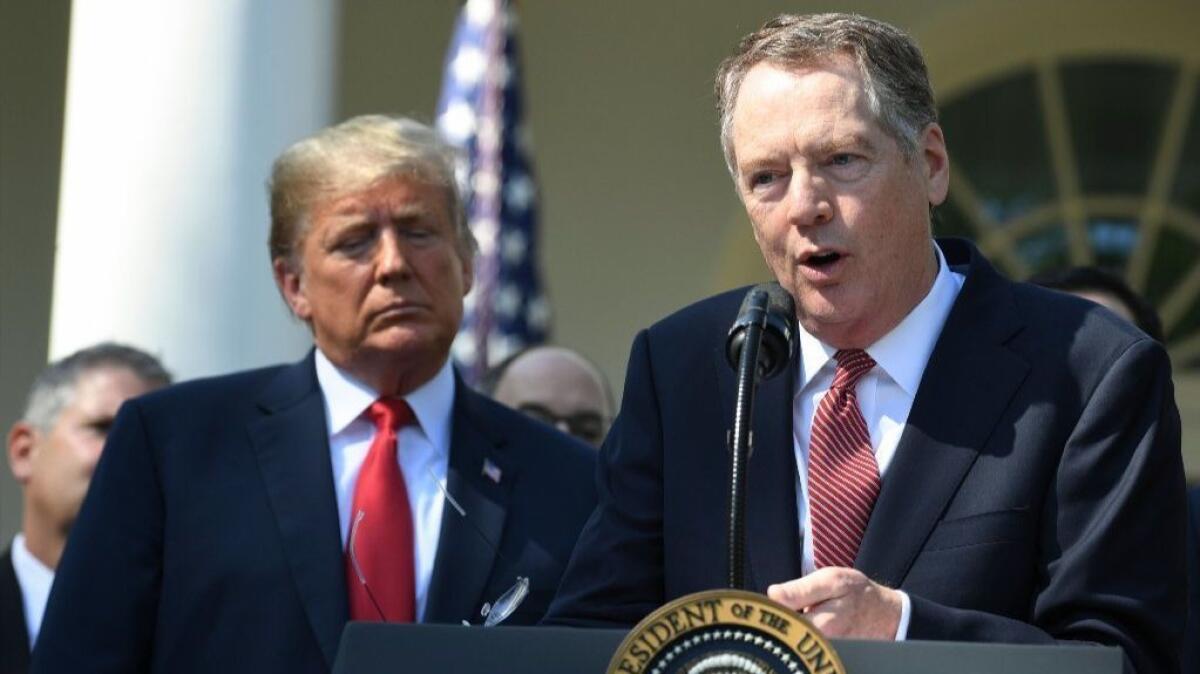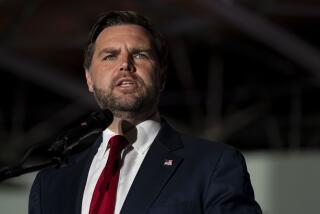To Trump’s trade czar, the key to boosting U.S. industry is playing hardball with China

Reporting from Washington — During heated trade talks with Japan in the 1980s, Robert Lighthizer, then a top negotiator under President Reagan, earned the nickname “missile man” after he took one of Japan’s written offers, folded it into a paper airplane and flung it at the opposing side.
More than 30 years on, Lighthizer is now leading the charge for President Trump in a much bigger and more consequential trade fight with China, which overtook Japan as the world’s second-largest economy in 2010.
The United States and China have exchanged several volleys of mass tariffs this year and are at an impasse. Where the two sides go from here, and how much more pain the administration is willing to exact and absorb, will depend in good part on Lighthizer’s judgment.
A veteran trade lawyer and experienced Washington hand, the guttural, blunt-speaking 71-year-old has had Trump’s ear from the start as the U.S. trade representative. But his recent success in closing an improbable deal with Canada and Mexico on a new North American Free Trade Agreement — a top campaign promise for Trump — firmly established Lighthizer as the administration’s most important voice on trade after the president.
Lighthizer shares Trump’s preference for hardball tactics and rebuilding domestic manufacturing, a conviction that for Lighthizer stems in part from his roots in the Rust Belt. He was born and raised in Ashtabula, Ohio, a onetime railroad and coal-transport town that, like Youngstown to the south, Erie, Pa., to the east and Cleveland to the west, has been pummeled by industrial decline.
“I don’t sense there’s any daylight between Lighthizer and the president,” said Alan Wolff, a longtime Washington attorney and now deputy director-general of the World Trade Organization. “The fundamental objectives have always been the same: Trade policy has to benefit the U.S. industrial base.”
That doesn’t mean Trump has a grand strategy on how to achieve that objective. Nor is it assured that Trump won’t settle with China for something less if it were to boost his personal stature or larger political goals. One test may come at the end of November in Buenos Aires, where world leaders will gather for the annual G-20 summit and where Trump is planning to meet with Chinese President Xi Jinping.
Because Trump has frequently spoken about his personal chemistry with Xi, some analysts wonder whether Trump could cut a modest or symbolic deal with the Chinese leader, as he did with North Korean ruler Kim Jong Un in Singapore. Administration officials have downplayed that possibility. And the fact that Lighthizer is expected to accompany Trump to Argentina diminishes those odds.
But on Thursday, Trump unexpectedly tweeted that he “just had a long and very good conversation” with Xi on trade and about North Korea. And on Friday, he told reporters: “We’re getting much closer to doing something. They very much want to make a deal. I think we’ll make a deal with China.”
Lighthizer has backed a ramp-up in tariffs to exert increasing pressure on China, saying that Beijing’s industrial policies present an existential threat to America’s economic future and that Chinese officials will be more likely to make meaningful concessions if they are pressed against the wall.
In September, the administration’s levies expanded to affect a total of some $250 billion of Chinese goods, half of all U.S. merchandise imports from China. Beijing has retaliated with duties on $110 billion of American-made products, or about 85% of all imports from the United States.
Even as American farmers and other businesses complain about the harm from tariffs, Lighthizer has shown no sense of urgency to sit down with Chinese counterparts. And he will almost certainly be urging Trump to press for concrete structural changes in China’s economic policies when he meets with Xi, rather than accept vague commitments and promises to buy a bunch more airplanes, soybeans and other goods to shave the U.S. trade deficit with China.
“His not talking with the Chinese makes it harder for the Trump-Xi meeting to have any substance on trade,” said Derek Scissors, a China scholar at the American Enterprise Institute who has advised the administration on China matters.
Scissors says Lighthizer and others in the administration want to shift supply chains and decouple America’s economic and investment links with China, a difficult process that could take many years and would undoubtedly be disruptive for parties on both sides.
Yet that is the direction that Washington appears to be driving toward. Lighthizer’s ascendance comes as the administration has recently laid down markers of what has arguably been a sea change in how America relates to China.
Ever since China’s opening up four decades ago under reform-minded leader Deng Xiaoping, U.S. administrations had largely pursued a policy of engagement with Beijing, betting that would lead to market liberalization and Western-style democratic reforms in the communist nation.
In recent years, though, many lawmakers and China policy hands in the West have come to the view that the strategy has not worked. Beijing has backpedaled on market opening pledges and, under Xi, increasingly thrown its military and financial weight around the region and beyond.
More recently, the U.S. or China has canceled regular economic and strategic dialogues that had been a part of the formalized relationship between the two countries. Instead, in a sweeping speech last month at the Hudson Institute, Vice President Mike Pence issued a lengthy attack accusing Beijing of military aggression, economic mercantilism and a broad range of nefarious activities, including meddling in the U.S. midterm election and infiltrating American universities.
While Pence offered limited evidence, the 40-minute broadside was seen by some experts as a declaration of a new cold war. It has been parsed over in Beijing and will almost certainly further complicate the trade conflict, said Cheng Li, a China expert at the Brookings Institution.
Lighthizer declined to be interviewed for this article, but he’s made clear that the United States can — and must — take a forceful stand against China’s state-led economic model.
He and many others in the West say Beijing has not kept up its part of the bargain when it was invited to enjoy the benefits of WTO membership in 2001 and that current international legal mechanisms are unable to deal effectively with Beijing’s market-distorting practices, such as China’s overproduction of steel, and policies that lead to coercion or outright theft of U.S. intellectual property.
A linchpin of the U.S. fight with China, at least in Lighthizer’s eyes, is Xi’s so-called Made in China 2025, an ambitious state-led plan to funnel billions of dollars to build up dominant Chinese firms in key sectors such as robotics, aviation, artificial intelligence and biomedicine.
“They have a system, and their system is challenging our system,” Lighthizer said in congressional testimony in July, telling senators that the U.S. struggle with China is “going to go on for years.”
In Trump, Lighthizer hopes he’s found a president whose trade focus will remain on promoting manufacturing at home rather than shaping foreign policy.
Lighthizer’s view “has long been that trade policy has taken a back seat to diplomatic and global strategic priorities,” said Bonnie Byers, a trade lawyer at King & Spalding who has known Lighthizer since the early 1990s.
But it remains to be seen whether Trump will keep that commitment. The president has previously said he would cut China slack on trade if Xi helped pressure North Korea to give up its nuclear weapons program.
Li of the Brookings Institution said Beijing clearly does not want to negotiate with Lighthizer, but now finds itself with little choice. In the past, the Chinese could rightfully complain about shifting or mixed signals coming from the White House as those committed to the nationalistic policies of Trump’s campaign vied with proponents of free-trade orthodoxy.
But no longer. The so-called globalist camp lost its most prominent proponent when National Economic Council Director Gary Cohn departed in March after failing to stop Trump from imposing blanket tariffs on steel imports. Cohn’s replacement, Larry Kudlow, and Treasury Secretary Steven T. Mnuchin are more pro-free trade and at times have tried to promote a softer approach. But they have been overshadowed by Lighthizer and Trump trade advisor Peter Navarro, a sharp China critic who has been at Trump’s side since the 2016 campaign but whose inexperience in Washington and truculence have hurt his effectiveness.
By contrast, Lighthizer is widely regarded as a skillful tactician and politically savvy, having learned his way around Congress beginning in the late 1970s from then-Sen. Bob Dole, for whom he worked as a minority counsel and later staff director of the Senate Finance Committee.
When Reagan tapped Lighthizer as a deputy U.S trade representative in 1983, the U.S. was already embroiled in a bitter trade conflict with Japan over allegations of dumping, subsidizing key industries and appropriating American technology. Similar complaints have been lodged against China, albeit on a larger scale.
Amid intense U.S. pressure and domestic considerations, Japan agreed by the mid-1980s to voluntarily limit its exports of steel, cars and other goods — a strategy of “managed trade” that Lighthizer more recently employed in renegotiating NAFTA and in his dealings with other countries.
“The key lesson of Japan was that the two countries were playing very different economic games,” said Clyde Prestowitz, who worked on Asia trade for Commerce in Reagan’s first term. “China and the U.S. are also playing different games.”
What’s different, Prestowitz said, is that the U.S. doesn’t have the automatic pressure points with Beijing, as China was never an American ally or under its security umbrella.
“Bob is well aware of this and is finding other means of gaining negotiating leverage,” he said.
Follow me at @dleelatimes
UPDATES:
Nov. 2, 12:15 p.m. : This article was updated with President Trump’s comments about Chinese President Xi Jinping.
This article was originally published on Nov. 1 at 3 a.m.
More to Read
Inside the business of entertainment
The Wide Shot brings you news, analysis and insights on everything from streaming wars to production — and what it all means for the future.
You may occasionally receive promotional content from the Los Angeles Times.











